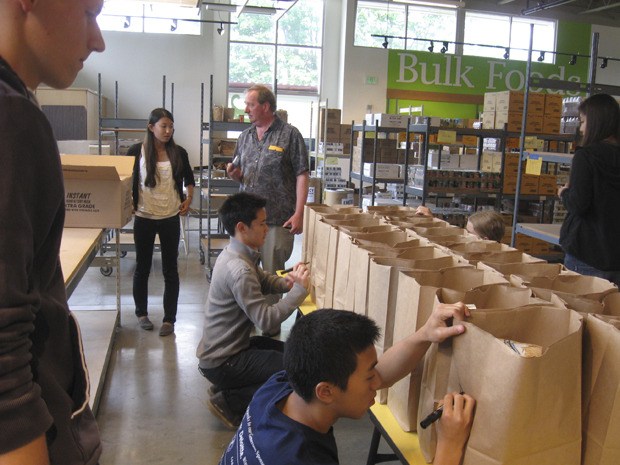By TRACEY COMPTON
tcompton@rentonreporter.com
A resource for the hungry will now be centered in South King County.
The Emergency Feeding Program of Seattle, King County is now operating their main warehouse out of the former Greenfresh Market building in Renton.
The nonprofit organization provides 2,000 bags of food a month to the hungry countywide. The program is leasing the space for two years from St.
Vincent de Paul, which purchased the building last October to expand their services in fall 2014.
The Emergency Feeding Program has been open a couple of weeks and continues to facilitate groups of volunteers to pack their bags of food.
Youth from a City of Mercer Island volunteer program recently donated their time to pack bags and organize.They are just one of the many groups who routinely help the program with their efforts.
There is no direct client distribution from the warehouse. It is an assembly, storage and distribution site to other agencies that provide food to clients.
Last year in Renton, 1,650 emergency food bags were delivered to partners at Aging and Disability Services, the Renton Department of Social and Health Services, St. Matthew’s Church, Harambee Church and Daystar Baptist Church. The program provided 513 bags of food to households in Auburn, and 1,408 to those in Kent through distribution partners in those cities.
“The need out there in the community is pretty great and it doesn’t really go down ever,” said Brian Anderson, operations director. “It’s pretty much a constant need for folks to make sure there’s enough food on the table for their families.”
About 1 and 5 households in the state are struggling in this situation, said Anderson about the last estimate he recalls.
The program experienced a 56 percent increase in the number of people requesting food between 2007 and 2010, he said.
“Over the last coupled of years, I got to tell you, it has been a struggle to keep up with those requests,” Anderson said.
The Emergency Feeding Program is different from a traditional food bank. The clients that are served through other agencies by the program, typically have other assistance.
These clients could be on food stamps or going to a food bank on a regular basis. The Emergency Feeding Program satisfies an immediate need for food in a crisis situation.
The program also is customized to meet the dietary and cultural needs of the clients.
There are 15 different versions of the bags they distribute. There are small, medium and large bags for different household sizes. There are diabetic, vegan/lactose-intolerant and all liquid diet bags. There are three different types of bags for people who don’t have access to a kitchen. There are two kinds of infant bags. And finally, there is a Latino, Asian and East African bag to fit the cultural needs of those new to this country.
“The idea is that it’s really not good enough to just give somebody something to eat,” Anderson said. “You want to be thoughtful about it. You want to give them something that suits their nutritional needs and takes into account their medical conditions and frankly their cultural preferences.”
The program was started in 1977 and based on a study by a University of Washington nutritionist.
The study found that the quality of food at food banks varied based on the affluence of the community where food banks were located. It also recognized the difficulty of a family to get nutritionally balanced food at a food bank in a single trip.
The Emergency Feeding Program started with just three different bag types and later moved to address different dietary and cultural needs.
They purchase roughly 70 percent of their food and get about 30 percent from donations.
They also get funds from the cities of Seattle, Renton, Kenmore, Bellevue, Federal Way and Tukwila. Money from the state’s Emergency Food Assistance Program, private donations, grants and support from faith communities rounds out the funding.
The program has one large truck, a van, a paid staff of four and two alternatively funded staff to carry out their mission. Volunteers help a great deal. Last year volunteers logged more than 2,300 hours in their warehouse.
Although they would like to have a permanent space or long-term lease agreement, their primary concern is feeding people right now, Anderson said.
Coming up in September the community can help the program and others like it to feed the hungry. The Mayor’s Day of Concern for the Hungry is Sept. 22.
It is a grocery store based food drive for area food banks, pantries and organizations like the Emergency Feeding Program.
Last year the day brought in 26 and a half tons of food for the Emergency Feeding Program alone.
For information on assistance or volunteer opportunities, contact the Emergency Feeding Program at 206-329-0300 or visit www.emergencyfeeding.org.
Talk to us
Please share your story tips by emailing editor@kentreporter.com.
To share your opinion for publication, submit a letter through our website https://www.kentreporter.com/submit-letter/. Include your name, address and daytime phone number. (We’ll only publish your name and hometown.) Please keep letters to 300 words or less.

